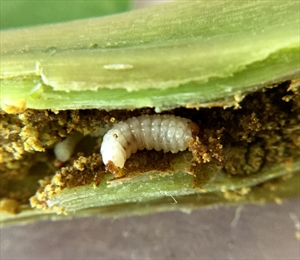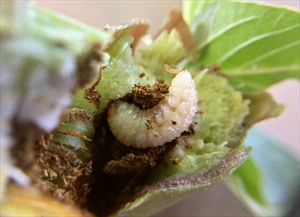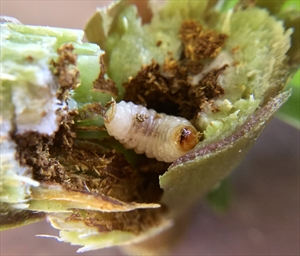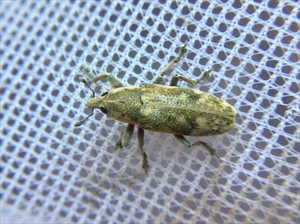- Restricted distribution. In Fiji. A weevil on Amaranthus species, both vegetables and weeds. Commonly called 'pigweeds'.
- Important pest. Damage by grubs (larvae) boring stems and branches. They spread Fusarium species causing decay and cankers. Pupate inside stem at base. Adults feed on leaves. Larvae spread in stems and adults on the wing.
- Natural enemies: Not reported; note, used as biocontrol of Amaranthus spinosus - major weed in Thailand.
- Cultural control: weed - especially wild amaranths; avoid adjacent overlapping crops; monitor frequently and pull out and burn wilted plants; collect and burn crop remains at harvest.
- Chemical control: PDPs (botanicals), e.g., neem, pyrethrum and derris; or synthetic products, e.g., malathion and pyrethroids. Note, effectiveness in doubt as larvae concealed within stems and branches.
Pacific Pests, Pathogens and Weeds - Online edition
Pacific Pests, Pathogens, Weeds & Pesticides
Amaranthus stem weevil (351)
Amaranthus stem weevil. Amaranthus weevil, pigweed weevil.
Hypolixus species. The species recorded by CABI1 are Hypolixus ritsemae, Hypolixus truncatus, and Hypolixus nublilosus. Hypolixus haerens is reported as the most common pigweed weevil in Kenya.
AUTHOR Grahame Jackson
1Information CABI Amaranthus spinosus (spiny amaranth) (2019) Crop Protection Compendium. (https://www.cabi.org/cpc/datasheet/4653); and Tara JS (2009) Bionomics of Hypolixus truncatulus (f.) (Coleoptera: Curculionidae: Lixinae: Lixini), a major pest of Amaranthus caudatus L. Mun. Ent. Zool. Vol. 4(2). (https://www.munisentzool.org/yayin/vol4/issue2/510-518.pdf); and Chittora A (2015) Insect pests of amaranthus and moringa. (https://www.slideshare.net/AkshayChittora/insect-pests-of-amaranthus-and-moringa-53613459); and Rajeshkanna et al. (2017) Biology and management of Amaranthus stem borer (Hypolixus trancatulus) Coleoptera: Curculionidae). Annals of Sri Lanka Department of Agriculture 19: 258-266. (https://www.doa.gov.lk/images/ASDA/ASDA_2017awards/TechnicalPapers/VOLUME1/ASDA_book_set3/19_82%20Rajeskhanna%20Amaranthus.pdf); and from Blodgett J, et al. (2004) Identification of fungi and fungal pathogens associated with Hypolixus haerens and decayed and cankered stems of Amaranthus hybridus. Plant Disease 88: 333-337. (https://apsjournals.apsnet.org/doi/10.1094/PDIS.2004.88.4.3339). Photos 1-5 Mani Mua, SPC, Sigatoka Research Station, Fiji.
Produced with support from the Australian Centre for International Agricultural Research under project HORT/2016/185: Responding to emerging pest and disease threats to horticulture in the Pacific islands, implemented by the University of Queensland and the Secretariat of the Pacific Community.








